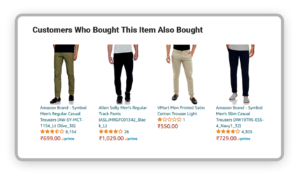Some people go to the grocery store with a standard list, while others find it difficult to stick to their list. Irrespective of what type of a buyer you are, retailers will always try to make various temptations to increase your spending.
Everyone of us have had those moments when we thought “Ohh, I might need this too”. Retailers increase their sales by leveraging this simple tendency of buyers.
For example, people buying bread are likely to buy butter as well. Hence, an experienced assortment manager will know that keeping a discount on bread will drive the sales of butter too.
You can find examples of Market Basket Analysis everywhere – from email campaigns, online shopping product recommendations to coupon offers.
Making relevant product recommendations by getting Market Basket Analysis right can be a game-changer for retailers. It can skyrocket their conversions and revenues.
Objective of Market Basket Analysis
The objective of Market Basket Analysis is identifying the next item that might appeal to a customer. This helps marketing and sales teams to design more effective product placement, pricing, up-sell, and cross-sell strategies. Additionally, it can help to predict sales of products in specific regions, improve warehouse operations and shipping times.
This translates into heightened revenues, higher profit, and lower costs.
Data Driven Strategies
Big retailers leverage detailed Market Basket Analysis to figure out associations between products. Employing this valuable information, they design various strategies to boost their revenues:
- Retailers place associated items close to one another, so that people buying one item would be tempted to buy the other.
- They apply discounts to only one of the associated items.
Association Rule Mining
When it comes to using Market Basket Analysis, a question may arise that how exactly is the technique carried out.
Market Basket Analysis is carried out by data scientists by implementing Association Rule Mining – a rule-based machine learning (ML) method that helps in discovering meaningful correlations between different items based on their co-occurrence in a data set.
Core Concepts of Association Rule Mining
Association Rule Learning involves three core measures. These are – Support, Confidence, and Lift.
-
Support
Support is the basic probability of the occurrence of an event. It is measured by the proportion of transactions in which a product set appears. In other words, Support (A) is the number of transactions that includes A divided by total number of transactions.
-
Confidence
The confidence of a consequent event, given that there is an antecedent event, can be explained using conditional probability. In simple words, confidence is the probability of the occurrence of event A, given that event B has already occurred.
This concept can be employed to describe the probability of a buyer purchasing an item when they have already placed another item in the basket. You can measure it by dividing the proportion of transactions with product X and Y, over the proportion of transactions with product Y.
You can write the conditional probability as:
Confidence = P (X and Y) / P (Y)
-
Lift
Lift can be defined as the observed to expected ratio (o/e). It measures how likely it is for a product to be purchased when another product is purchased, while controlling how popular both the products are. You can calculate Lift by dividing the probability of both the products occurring together by the product of probabilities of both individual products occurring, considering there is no association between them.
Lift = Support (X, Y) / Support (X) x Support (Y)
The Apriori Algorithm
One of the most prominent algorithms employed in association rule learning for relational databases is the Apriori Algorithm. The algorithm identifies the products in a data set and extends them further to bigger and bigger item sets.
However, this algorithm extends only if the item sets are frequent, that is the item set’s probability is beyond a particular predetermined threshold.
To explain it formally,
The algorithm proposes that:
An item set’s probability is not frequent if:
- P (I) < Minimum support threshold, where I is a non-empty item set
- The value of any subset in the item set is less than minimum support
The second characteristic among the above is known as the Anti-monotone Property. An example for this would be if the probability of buying a bread is already below the minimum support, the probability of buying a bread and butter will be definitely below the minimum support too.
Market Basket Analysis and Recommendation Engines
Retailers leveraged Market Basket Analysis to know the way to optimize shelf space for driving sales. In early days, retailers would firstly use data mining algorithms for generating reports. Secondly, the reports would show them the association rules that were the strongest. Additionally, using this information, retailers would identify cross-selling opportunities and plan promotions.
After the advent of the internet, retail businesses went online, and new opportunities emerged. Now, online retailers can make product recommendations while customers browse items.
Recommendation engines are software applications that identify which related products to display. These engines are behind features such as “people who purchased these items, also purchased.”

Market Basket Analysis is one of the analytics techniques employed by recommendation engines. They can also leverage the past preferences and purchases of users.
Some examples of recommendation engines in effect are:
- Netflix showing you movies you might like
- Spotify generating a “Radio Station” on the basis of a current album or song
- Amazon’s main page uses recommendation engines to display items similar to the ones you have previously browsed
Applications of Market Basket Analysis
-
Cross-selling and Upselling
Cross-selling is a technique in which retailers suggest complementary products to a customer with the primary product that they have already purchased. Upselling, another sales technique, makes a customer spend more by making them buy a premium or upgraded version of what they are purchasing. Market Basket Analysis helps retailers gain an understanding of customer behavior and then proceed for cross-selling and/or upselling.
-
Affinity Promotion
This is a technique that helps to find out the co-occurrence relationships between the products bought by specific groups or individuals using data analytics. By understanding the purchase behavior of customers, retailers can make decisions on store layouts, loyalty programs, cross-selling, and design discount plans.
-
Customer Behavior
This is the study of how an individual or a customer group purchases to fulfill their wants and needs. Retail Market Basket Analysis helps to gain an understanding of consumer behavior. It gives an insight into the purchase patterns of customers and helps retailers identify the relationship between two items where a customer tends to make a purchase.
-
Fraud Detection
Market Basket Analysis is also used for fraud detection. Retailers can identify fraudulent transactions by gaining an understanding of customer behavior under different conditions. For example, data containing credit card usage can help retailers detect fraud, which is associated with customer purchase behavior.
To Sum Up
Market Basket Analysis has enormous potential for all organizations to explore avenues of growth by discovering the hidden relationships and associations among products. For retailers that get it correct, can experience significant and measurable growth in revenues as well as customer retention.
To implement the technique right, it can help retailers to have expert marketing consultants by their side. aQb Solutions can help you make the most of Market Basket Analysis for the benefit of your retail business. Our expert marketing consultants can guide you right in this field. To know more, get in touch with us today!




